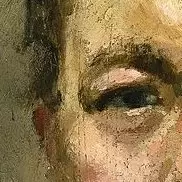Unlike his Impressionist friends, Degas was an essentially urban painter, who liked to paint the enclosed spaces of stage shows, leisure activities and pleasure spots.
In a cafe, a fashionable meeting place, a man and a woman, although sitting side-by-side, are locked in silent isolation, their eyes empty and sad, with drooping features and a general air of desolation. The painting can be seen as a denunciation of the dangers of absinthe, a violent, harmful liquor which was later prohibited. Parallels have been drawn with Zola’s novel L’Assommoir written a few years later and indeed the novelist told the painter: “I quite plainly described some of your pictures in more than one place in my pages.” The realistic dimension is flagrant: the cafe has been identified - it is “La Nouvelle Athènes”, in place Pigalle, a meeting place for modern artists and a hotbed of intellectual bohemians. The framing gives the impression of a snapshot taken by an onlooker at a nearby table. But this impression is deceptive because, in fact, the real life effect is carefully contrived. The picture was painted in the studio and not in the cafe.
Degas asked people he knew to pose for the figures: Ellen André was an actress, and an artist’s model; Marcellin Desboutin was an engraver and artist. The painting cast a slur on their reputations and Degas had to state publicly that they were not alcoholics.
The off-centre framing, introducing empty spaces and slicing off the man’s pipe and hand, was inspired by Japanese prints, but Degas uses it here to produce a drunken slewing. The presence of the shadow of the two figures painted as a silhouette reflected in the long mirror behind them is also expressive and significant.


Thank you for including the background information. This is a wonderful image, and I was particularly struck by how the mirror was handled.